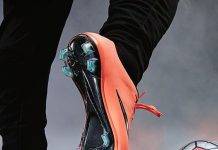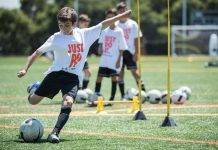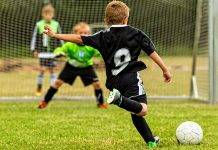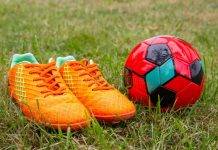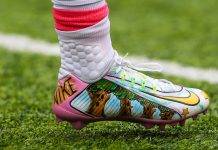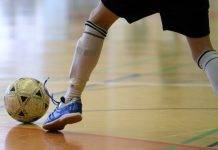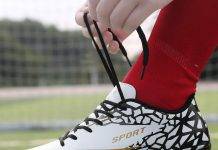Are you a parent with a young athlete itching to try different sports?
Well, if your child has recently expressed interest in both baseball and football, you might find yourself pondering a peculiar question: Can my kid wear baseball cleats for football?
In this article, we’ll explore the compatibility of these two types of cleats and provide you with all the necessary information to make an informed decision for your little one’s sports gear.
So, let’s lace up and discover if your future football star can slip into those trusty baseball cleats.
The Difference Between Baseball and Football Cleats
When choosing the proper footwear for different sports, it’s essential to understand the differences between baseball and football cleats. Both cleats are designed to provide traction and support on grassy surfaces, but there are some critical differences in their design and construction.
Review contents
The Design and Construction
Baseball cleats are typically made with a low-cut design for greater flexibility and mobility. They are designed to provide optimal traction for quick movements on dirt and grass surfaces. On the other hand, football cleats often feature a higher cut and a sturdier construction to provide ankle support during the intense lateral movements and tackles often seen in football.
The Traction and Studs
One of the main differences between baseball and football cleats lies in their traction. Baseball cleats usually have metal or rubber studs on the outsole to provide grip and prevent slipping on the baseball diamond. These studs are shorter and more evenly distributed to allow for quick and agile movements on the field. On the other hand, football cleats typically have longer and more pronounced studs specifically designed for traction on grass surfaces. These studs are strategically placed to provide stability and grip during the quick bursts of speed and sudden changes in direction commonly seen in football.
The Comfort and Flexibility
Comfort and flexibility are essential when choosing between baseball and football cleats. Baseball cleats are often designed to focus on lightweight materials and flexibility for quick movements and responsiveness. In contrast, football cleats prioritize stability and support, which often means sacrificing some degree of flexibility. The higher cut and sturdier construction of football cleats provide extra ankle support, which can be beneficial in a sport that involves frequent cutting and changes in direction.
Considerations When Wearing Baseball Cleats for Football
While some athletes may be tempted to use baseball cleats for football, several essential considerations should be considered before making this decision.
Field Conditions
One of the primary considerations when wearing baseball cleats for football is the condition of the playing field. Football is primarily played on grass fields, while baseball is played on a variety of surfaces including dirt, grass, and artificial turf. Baseball cleats are specifically designed for use on dirt and grass, and they may not provide adequate traction on a football field. The longer studs on football cleats are designed to penetrate the grass and provide optimal traction, which may be lacking in baseball cleats.
Injury Risk
Using baseball cleats for football can also increase the risk of injuries. Baseball cleats are not designed to withstand the intense physical contact and lateral movements of football. Baseball cleats’ lower cut and lighter construction may not provide sufficient ankle support, which can increase the risk of ankle sprains and other injuries. On the other hand, football cleats are designed with the specific demands of football in mind and offer better protection against injuries.
Performance Limitations
Using baseball cleats for football may also lead to performance limitations. Football cleats are specifically designed to enhance performance in football, with features such as improved traction, stability, and support. Baseball cleats, while suitable for baseball, may not provide the same level of performance and may hinder the athlete’s ability to perform at their best in a football game. It is essential to consider these performance limitations before deciding to use baseball cleats for football.
Advantages of Using Football Cleats
While baseball cleats may not be ideal for football, there are several advantages to using football cleats that should be considered.
Improved Traction
Football cleats are specifically designed to provide optimal traction on grass fields. The longer and more pronounced studs on football cleats are strategically placed to penetrate the grass and provide superior grip, giving athletes an advantage when it comes to quick bursts of speed, lateral movements, and changes in direction.
Enhanced Stability
Stability is crucial in football, especially when it comes to maintaining balance during tackles and cuts. Football cleats are designed with a higher cut and a sturdier construction to provide extra ankle support and stability. This can help reduce the risk of ankle injuries and provide athletes with the confidence to perform at their best.
Reduced Injury Risk
Using the appropriate footwear for a specific sport can help reduce the risk of injuries. Football cleats are designed with the specific demands of football, offering superior protection against physical contact and intense lateral movements expected in the sport. The stability, ankle support, and durable construction of football cleats make them a safer choice for football players.
Alternatives to Football Cleats for Baseball
If baseball cleats are unsuitable for football, what alternatives exist for players who want to play football? Here are a few options to consider:
Molded Baseball Cleats
Molded baseball cleats are a good alternative for baseball players who want to play football. These cleats have shorter and more evenly distributed studs that provide traction on grass fields while still allowing for quick and agile movements. Molded baseball cleats offer better support and stability than traditional ones, making them a safer and more suitable option for football.
Turf Shoes
Turf shoes are another option for baseball players who want to play football. These shoes are designed for artificial turf surfaces and provide excellent traction without studs. Turf shoes have a flat rubber outsole that grips the turf surface, allowing athletes to make quick movements without the risk of slipping. While not ideal for grass fields, turf shoes can be a suitable alternative for football on artificial turf.
Metal Baseball Cleats
Metal baseball cleats, with their longer and sharper studs, are not recommended for football. These cleats are designed specifically for dirt and grass surfaces in baseball and can pose a higher risk of injury on football fields. Metal cleats can cause excessive damage to the playing field and may result in penalties or fines. It is best to avoid using metal baseball cleats for football.
Tips for Choosing the Right Cleats
Choosing the right cleats is crucial for both performance and safety. Here are a few tips to help you make the right choice:
Consulting with Coaches and Experts
When choosing cleats, it’s always a good idea to consult with your coaches and experts in the field. They can provide valuable insights and recommendations based on their experience and knowledge of the sport. Coaches and experts can help you determine the appropriate cleat type, style, and size that best suits your needs and playing style.
Considering Position and Playing Style
Your position and playing style should also influence your choice of cleats. Different positions require different types of movement and have specific demands on the field. For example, linemen may benefit from cleats with extra ankle support and stability, while wide receivers may prefer cleats that allow for more incredible speed and agility. Consider your position and playing style when choosing cleats to maximize your performance.
Trying Different Brands and Models
Not all cleats are created equal; what works for one athlete may not work for another. Try different brands and models to find a comfortable cleat with optimal performance. Many primary sporting goods stores offer a wide selection of cleats, allowing you to try different options and find the perfect fit.
Ensuring Proper Fit and Safety
The proper fit of your cleats is essential for both comfort and safety. Here are a few considerations to keep in mind:
Getting the Right Size and Width
Cleats should fit snugly but not too tight to ensure optimal performance and reduce the risk of foot injuries. It’s essential to get the right size and width for your feet. Try several sizes and widths to find the most comfortable and secure fit. Remember that cleats may require a breaking-in period, so give yourself enough time to adjust to the new footwear.
Proper Lacing Technique
Proper lacing techniques can help ensure a secure fit and reduce the risk of foot injuries. Lace your cleats tightly, starting from the bottom and working up. Make sure to tie a double knot to prevent the laces from coming undone during play. Adjust the tightness as needed to achieve a comfortable and secure fit.
Maintaining and Replacing Cleats
Regular maintenance and proper care can help prolong the life of your cleats and ensure their optimal performance. Clean your cleats after each use to remove dirt and debris that can degrade the materials and affect traction. Inspect your cleats regularly for wear and tear, such as worn-out studs or damaged outsoles. Replace your cleats when they show significant signs of wear to maintain safety and performance.
Avoiding Misuse and Potential Damage
To ensure the longevity and effectiveness of your cleats, it’s important to use them for their intended purpose and take proper care of them. Here are a few tips to avoid misuse and potential damage:
Using Cleats for Intended Purpose
Each type of cleat is designed for a specific sport and playing surface. Using cleats for a different sport or surface can result in decreased performance, increased risk of injury, and damage to the cleats. It’s essential to use cleats for their intended purpose to ensure optimal performance, safety, and longevity.
Storing and Cleaning Cleats
Properly storing and cleaning your cleats can help maintain their condition and extend their lifespan. After each use, clean your cleats to remove dirt and debris that can degrade the materials and affect performance. Store your cleats in a cool, dry place away from direct sunlight and extreme temperatures. Avoid storing them in damp or humid areas, as this can promote mold and bacteria growth.
Replacing Cleats Accordingly
Cleats, like any other sports equipment, have a limited lifespan. As the studs wear down or become damaged, the traction and performance of the cleats will decline. It’s essential to inspect your cleats and replace them when necessary regularly. Ignoring signs of wear and tear can lead to decreased performance, increased risk of injury, and potentially costly damage to the playing surface.
Reviewing Regulations and Guidelines
Different leagues and organizations have rules and regulations regarding footwear on the field. Reviewing and adhering to these rules is essential to ensure fair play and avoid penalties. Familiarize yourself with the regulations and guidelines set by your league or organization regarding cleat types, stud length, and other equipment specifications. By following these regulations, you can ensure a level playing field and maintain the safety of all players.
League and Organization Rules
Different leagues and organizations, whether youth sports or professional leagues, have their own field footwear rules. These rules often specify the types of allowed cleats and the stud length and configuration. Review the rules set by your league or organization to ensure that you are using cleats that are compliant and within the guidelines.
Safety Standards
Safety is a top priority in any sport, and cleats must meet specific safety standards to ensure player protection. Organizations such as the American Society for Testing and Materials (ASTM) set safety standards for sports equipment, including cleats. Look for cleats that meet or exceed these safety standards to ensure you wear footwear that protects against injuries.
Equipment Specifications
In addition to rules and safety standards, there are often equipment specifications to consider when choosing cleats. These specifications may include requirements for stud length, material, and configuration. Reviewing the equipment specifications your league or organization sets and ensuring that your cleats meet the requirements is essential. Adhering to these specifications can help maintain a level playing field and ensure fair competition.
The Importance of Comfort and Performance
Comfort and performance go hand in hand when choosing the right footwear for any sport. Here are a few reasons why comfort and performance should be prioritized:
Impact on Overall Performance
Comfortable cleats can significantly impact an athlete’s overall performance. When athletes are comfortable in their footwear, they can focus more on their technique, strategy, and performance on the field. Ill-fitting or uncomfortable cleats can distract and hinder an athlete’s ability to perform at their best.
Preventing Foot Injuries
Properly fitting and comfortable cleats can help prevent foot injuries. When cleats are too tight, too loose, or rub against the foot, they can cause blisters, calluses, and other foot injuries. Also, ill-fitting cleats can affect athletes’ gait and balance, increasing the risk of trips, falls, and ankle sprains. Prioritizing comfort and ensuring that cleats fit correctly can help reduce the risk of foot injuries.
Ensuring Comfort and Agility
Comfortable cleats allow for better agility and quick movements on the field. When athletes feel comfortable in their footwear, they can move more freely and responsively, which is essential in sports like football, requiring quick reactions and direction changes. Uncomfortable or poorly fitting cleats can restrict movement and hinder an athlete’s agility and performance.
Parental Considerations and Decision-making
For parents, choosing the right cleats for their child involves considering safety and personal preference. Here are a few things for parents to keep in mind when making decisions about cleats:
Balancing Safety and Preference
Parents must balance their child’s safety with their preferences and desires. While a child may prefer a specific type of cleat, it’s important to prioritize their safety and performance on the field. Consider the specific demands of the sport, the playing surface, and any regulations or guidelines set by the league or organization when making decisions about cleats.
Understanding Child’s Needs
Every child is unique and has different needs when it comes to footwear. Consider your child’s foot shape, size, and specific foot conditions or concerns when choosing cleats. It may be helpful to consult with a podiatrist or footwear specialist who can guide your child to the best type of cleats. Understanding and considering your child’s needs can help ensure a proper fit and maximize their comfort and performance.
Considering Long-term Effects
Choosing the right cleats is not only about the child’s immediate needs but also about the long-term effects. Ill-fitting or inappropriate cleats can lead to foot injuries and other foot problems that can potentially impact a child’s athletic career in the long run. It’s essential to consider the potential long-term effects of cleat choices and prioritize the health and well-being of your child.
In conclusion, the difference between baseball and football cleats lies in their design, construction, traction, and comfort. While there may be some overlap in field conditions and performance limitations, it is generally not recommended to wear baseball cleats for football.
Football cleats are specifically designed to enhance traction stability and reduce the risk of injury on grass fields. However, there are alternative options such as molded baseball cleats, turf shoes, and metal baseball cleats that may be suitable for baseball players who want to play football.
When choosing cleats, it is essential to consult with coaches and experts, consider position and playing style, and try different brands and models to find the best fit. Ensuring proper fit and safety involves getting the right size and width, using proper lacing techniques, and maintaining and replacing cleats when necessary.
Avoiding misuse and potential damage requires using cleats for their intended purpose, storing and cleaning them properly, and replacing them accordingly.
Reviewing regulations and guidelines set by leagues and organizations is crucial to ensure compliance and safety. Considering the importance of comfort and performance can have a significant impact on an athlete’s overall performance and reduce the risk of foot injuries.
For parents, making decisions about cleats involves balancing safety and preference, understanding their child’s needs, and considering the long-term effects on their child’s athletic career. By following these considerations, athletes and parents can make informed decisions when it comes to choosing the right cleats for their respective sports.



